Black Sea Turtle (Chelonia mydas agassizii) Life History in the Sanctuary of Colola Beach, Michoacan, Mexico
Abstract
Simple Summary
Abstract
1. Introduction
Black Turtle Life History Traits (Chelonia mydas agassizii)
2. Materials and Methods
2.1. Statistical Analyses
2.2. Mathematical Calculations
3. Results
3.1. Body Size
3.2. Clutch Size
3.3. Egg Size
3.4. Fecundity
3.5. Remigration Interval
3.6. Sexual Maturity
4. Discussion
5. Conclusions
Author Contributions
Funding
Institutional Review Board Statement
Informed Consent Statement
Data Availability Statement
Acknowledgments
Conflicts of Interest
References
- Stearns, S.C. Life history evolution: Successes, limitations, and prospects. Sci. Nat. 2000, 87, 476–486. [Google Scholar] [CrossRef]
- Wapstra, E.; Swain, R. Geographic and Annual Variation in Life-History Traits in a Temperate Zone Australian Skink. J. Herpetol. 2001, 35, 194. [Google Scholar] [CrossRef]
- Begon, M.; Parker, G.A. Should Egg Size and Clutch Size Decrease with Age? Oikos 1986, 47, 293. [Google Scholar] [CrossRef]
- Stearns, S. Life-History Tactics: A Review of the Ideas. Q. Rev. Biol. 1976, 51, 3–47. [Google Scholar] [CrossRef] [PubMed]
- Pascual, M.; Rives, B.; Schunter, C.; Macpherson, E. Impact of life history traits on gene flow: A multispecies systematic review across oceanographic barriers in the Mediterranean Sea. PLoS ONE 2017, 12, e0176419. [Google Scholar] [CrossRef]
- Jensen, M.P.; FitzSimmons, N.N.; Dutton, P.H.; Michael, P. Molecular genetics of sea turtles. In The Biology of Sea Turtles; Wyneken, J., Lohmann, J., Musick, J.A., Eds.; CRC Press: Boca Raton, FL, USA, 2013; pp. 135–161. [Google Scholar]
- Bowen, B.W.; Karl, S.A. Population genetics and phylogeography of sea turtles. Mol. Ecol. 2007, 16, 4886–4907. [Google Scholar] [CrossRef] [PubMed]
- Karl, S.A.; Bowen, B.W. Evolutionary Significant Units versus Geopolitical Taxonomy: Molecular Systematics of an Endangered Sea Turtle (genus Chelonia). Conserv. Biol. 1999, 13, 990–999. [Google Scholar] [CrossRef]
- Van Buskirk, J.; Crowder, L.B. Life-History Variation in Marine Turtles. Copeia 1994, 1994, 1446672. [Google Scholar] [CrossRef]
- Seminoff, J.A.; Resendiz, A.; Nichols, W.J.; Jones, T.T. Growth Rates of Wild Green Turtles (Chelonia mydas) at a Temperate Foraging Area in the Gulf of California, México. Copeia 2002, 2002, 610–617. [Google Scholar] [CrossRef]
- Mrosovsky, N. Conserving Sea Turtles (No. C/333.95716 M7); British Herpetological Society: London, UK, 1983. [Google Scholar]
- Kobayashi, S.; Aokura, N.; Fujimoto, R.; Mori, K.; Kumazawa, Y.; Ando, Y.; Matsuda, T.; Nitto, H.; Arai, K.; Watanabe, G.; et al. Incubation and water temperatures influence the performances of loggerhead sea turtle hatchlings during the dispersal phase. Sci. Rep. 2018, 8, 11911. [Google Scholar] [CrossRef]
- LeBlanc, A.M.; Rostal, D.C.; Drake, K.K.; Williams, K.L.; Frick, M.G.; Robinette, J.; Barnard-Keinath, D.E. The Influence of Maternal Size on the Eggs and Hatchlings of Loggerhead Sea Turtles. Southeast. Nat. 2014, 13, 587. [Google Scholar] [CrossRef]
- Miller, J.D. Reproduction in sea turtles. The Biology of Sea Turtles; CRC Press: Boca Raton, FL, USA, 2017; pp. 51–81. ISBN 9780203737088. [Google Scholar]
- Owens, D.W.; Morris, Y.A. The Comparative Endocrinology of Sea Turtles. Copeia 1985, 1985, 723. [Google Scholar] [CrossRef]
- Hirth, H.F. Some Aspects of the Nesting Behavior and Reproductive Biology of Sea Turtles. Am. Zoöl. 1980, 20, 507–523. [Google Scholar] [CrossRef]
- McClellan, C.M.; Braun-McNeill, J.; Avens, L.; Wallace, B.P.; Read, A.J. Stable isotopes confirm a foraging dichotomy in juvenile loggerhead sea turtles. J. Exp. Mar. Biol. Ecol. 2010, 387, 44–51. [Google Scholar] [CrossRef]
- Whiting, S.D.; Murray, W.; Macrae, I.; Thorn, R.; Chongkin, M.; Koch, A.U. Non-migratory breeding by isolated green sea turtles (Chelonia mydas) in the Indian Ocean: Biological and conservation implications. Sci. Nat. 2007, 95, 355–360. [Google Scholar] [CrossRef]
- Bolten, A.B.; Lutz, P.L.; Musick, J.A.; Wyneken, J. Variation in sea turtle life history patterns: Neritic vs. oceanic developmental stages. Biol. Sea Turt. 2003, 2, 243–257. [Google Scholar]
- Carr, A.; Meylan, J.A.; Mortimer, K. Surveys of sea turtles populations and habitats in the Western Atlantic. NOAA Tech. Memo. 1982, 82, 1. [Google Scholar]
- Broderick, A.C.; Glen, F.; Godley, B.J.; Hays, G.C. Variation in reproductive output of marine turtles. J. Exp. Mar. Biol. Ecol. 2003, 288, 95–109. [Google Scholar] [CrossRef]
- Hirth, H.F. Synopsis of Biological Data on the Green Turtle, Chelonia mydas (Linnaeus 1758); FAO Fisheries Synopsis: Roma, Italy, 1971; FIRM/S85:1-75; ISBN 2-8317-0364-6. [Google Scholar]
- Casale, P.; Mazaris, A.D.; Freggi, D. Estimation of age at maturity of loggerhead sea turtles Caretta caretta in the Mediterranean using length-frequency data. Endanger. Species Res. 2011, 13, 123–129. [Google Scholar] [CrossRef]
- Omeyer, L.C.M.; Godley, B.J.; Broderick, A.C. Growth rates of adult sea turtles. Endanger. Species Res. 2017, 34, 357–371. [Google Scholar] [CrossRef]
- Read, T.C.; Wantiez, L.; Werry, J.M.; Farman, R.; Petro, G.; Limpus, C.J. Migrations of green turtles (Chelonia mydas) between nesting and foraging grounds across the Coral Sea. PLoS ONE 2014, 9, e100083. [Google Scholar] [CrossRef]
- Tiwari, M.; Bjorndal, K.A. Variation in morphology and reproduction in the Loggerheads, Caretta caretta, nesting in the United States, Brazil, and Greece. Herpetologica 2000, 56, 343–356. [Google Scholar]
- Casale, P.; Ceriani, S. Sea turtle populations are overestimated worldwide from remigration intervals: Correction for bias. Endanger. Species Res. 2020, 41, 141–151. [Google Scholar] [CrossRef]
- Hendrickson, J.R. The Ecological Strategies of Sea Turtles. Am. Zoöl. 1980, 20, 597–608. [Google Scholar] [CrossRef]
- Limpus, C.; Miller, J.; Paramenter, C.; Reimer, D.; McLachlan, N.; Webb, R. Migration of green (Chelonia mydas) and loggerhead (caretta caretta) turtles to and from eastern Australian rookeries. Wildl. Res. 1992, 19, 347–357. [Google Scholar] [CrossRef]
- Hamann, M.; Limpus, C.J.; Owens, D.W.; Lutz, P.L.; Musick, J.A.; Wyneken, J. Reproductive cycles of males and females. In The Biology of Sea Turtles; Lutz, P.L., Musick, J.A., Wyneken, J., Eds.; CRC Press: Boca Raton, FL, USA, 2003; pp. 135–161. [Google Scholar]
- Jones, S.M. Hormonal Regulation of Ovarian Function in Reptiles. In Hormones and Reproduction of Vertebrates; Academic Press: Cambridge, MA, USA, 2011; pp. 89–115. [Google Scholar] [CrossRef]
- Fitzsimmons, N.N.; Tucker, A.D.; Limpus, C.J. Long-term breeding histories of male green turtles and fidelity to a breeding ground. Mar. Turt. Newsl. 1995, 68, 2–4. [Google Scholar]
- Wilbur, H.M.; Morin, P.J. Life history evolution in turtles. Biol. Reptil. 1988, 16, 387–439. [Google Scholar]
- Blanvillain, G.; Owens, D.W.; Kuchling, G. Hormones and Reproductive Cycles in Turtles. In Hormones and Reproduction of Vertebrates; Academic Press: Cambridge, MA, USA, 2011; pp. 277–303. [Google Scholar] [CrossRef]
- Bjorndal, K.A.; Schroeder, B.A.; Foley, A.M.; Witherington, B.E.; Bresette, M.; Clark, D.; Herren, R.M.; Arendt, M.D.; Schmid, J.R.; Meylan, A.B.; et al. Temporal, spatial, and body size effects on growth rates of loggerhead sea turtles (Caretta caretta) in the Northwest Atlantic. Mar. Biol. 2013, 160, 2711–2721. [Google Scholar] [CrossRef]
- Gatto, C.R.; Robinson, N.J.; Spotila, J.R.; Paladino, F.V.; Tomillo, P.S. Body size constrains maternal investment in a small sea turtle species. Mar. Biol. 2020, 167, 1–11. [Google Scholar] [CrossRef]
- Bjorndal, K.A.; Bolten, A.B. Comparison of straight-line and over-the-curve measurements for growth rates of green turtles, Chelonia mydas. Bull. Mar. Sci. 1989, 45, 189–192. [Google Scholar]
- Bjorndal, K.A.; Bolten, A.B. Growth Rates of Immature Green Turtles, Chelonia mydas, on Feeding Grounds in the Southern Bahamas. Copeia 1988, 1988, 555. [Google Scholar] [CrossRef]
- Carr, A. Handbook of Turtles; Cornell University Press: Ithaca, NY, USA, 1952. [Google Scholar]
- Bocourt, M. Description de quelques cheloniens nouveaux appartenant a la Faune Mexicaine. Ann. Sci. Nat. Zool. 1868, 10, 1–3. [Google Scholar]
- Ernst, C.H.; Barbour, R.W. Turtles of the World; Smithsonian Institution Press: Washington, DC, USA, 1989. [Google Scholar]
- Pritchard, P.; Bacon, F.; Berry, A.; Carr, J.; Fletmeyer, R.; Gallagher, S.; Hopkins, R.; Lankford, R.; Marquez, L.; Ogren, W.; et al. Manual Sobre Técnicas de Investigación y Conservación de Las Tortugas Marinas; Center for Environmental Education: Washington, DC, USA, 1983; 134p. [Google Scholar]
- Rainey, W.E.; Cornelius, S.E. The Sea Turtles of Santa Rosa National Park; Fundación de Parques Nacionales: San Jose, Costa Rica, 1987. [Google Scholar] [CrossRef]
- Marquez, R. Sea Turtles of the World. An Annotated and Illustrated Catalogue of Sea Turtle Species Know to Date; FAO Fisheries Synopsis: Roma, Italy, 1990; Volume 11, 81p. [Google Scholar]
- Kamezaki, N.; Matsui, M. Geographic Variation in Skull Morphology of the Green Turtle, Chelonia mydas, with a Taxonomic Discussion. J. Herpetol. 1995, 29, 51. [Google Scholar] [CrossRef]
- Okamoto, K.; Kamezaki, N. Morphological variation in Chelonia mydas (Linnaeus, 1758) from the coastal waters of Japan, with special reference to the turtles allied to Chelonia mydas agassizii Bocourt, 1868. Curr. Herpetol. 2014, 33, 46–56. [Google Scholar] [CrossRef]
- Alvarado, J.; Figueroa, A. The Ecological Recovery of Sea Turtles of Michoacan, Mexico. Special Attention: The Black Turtle, Chelonia agassizii; Final Report 1988–1989; US Fish & Wildlife Service: Albuquerque, NM, USA, 1989. [Google Scholar]
- Bowen, B.W.; Meylan, A.B.; Ross, J.P.; Limpus, C.J.; Balazs, G.H.; Avise, J.C. Global population structure and natural history of the green turtle (Chelonia mydas) in terms of matriarchal phylogeny. Evolutionary 1992, 46, 865–881. [Google Scholar]
- Alvarado, J.; Figueroa, A. Recapturas post-anidatorias de hembras de tortuga marina negra (Chelonia agassizii) marca-das en Michoacán, Mexico. Biotropica 1992, 24, 560–566. [Google Scholar] [CrossRef]
- Alvarado-Díaz, J.; Delgado-Trejo, C.; Suazo-Ortuño, I. Evaluation of black turtle project in Michoacán, México. Mar. Turt. Newsl. 2001, 92, 4–7. [Google Scholar]
- Figueroa, A.; Alvarado, J.; Hernández, F.; Rodríguez, G.; Robles, J. The ecological recovery of sea turtles of Michoacán, México. Special attention to the black turtle (Chelonia agassizii); Final Report to WWF-USFWS; US Fish & Wildlife Service: Albuquerque, NM, USA, 1993. [Google Scholar]
- Alvarado, J.; Figueroa, A. Comportamiento reproductivo de la tortuga negra Chelonia agassizii. Ciencia desar-rollo 1991, 17, 43–49. [Google Scholar]
- Alvarado, J.; Figueroa, A.; Delgado, C.; Sanchez, M.T.; Lopez, E. Differential retention of metal and plastic tags on the black sea turtle (Chelonia agassizii). Herpetological. Rev. 1993, 24, 23–24. [Google Scholar]
- Guzman, H.M.; Rogers, G.; Gomez, C.G. Behavioral States Related to Environmental Conditions and Fisheries During Olive Ridley Turtle Migration From Pacific Panama. Front. Mar. Sci. 2019, 6, 770. [Google Scholar] [CrossRef]
- Jensen, M.P.; FitzSimmons, N.N.; Dutton, P.H.; Michael, P. Molecular genetics of sea turtles. Biol. Sea Turt. 2013, 3, 135–161. [Google Scholar]
- Peery, M.Z.; Kirby, R.; Reid, B.N.; Stoelting, R.; Doucet-Bëer, E.; Robinson, S.; Vásquez-Carrillo, C.; Pauli, J.N.; Palsbøll, P.J. Reliability of genetic bottleneck tests for detecting recent population declines. Mol. Ecol. 2012, 21, 3403–3418. [Google Scholar] [CrossRef] [PubMed]
- Iverson, J.B. Adaptations to herbivory in Iguanine lizards. In Iguanas of the World: Their Behavior, Ecology and Conservations; Burghardt, G.M., Rand, A.S., Eds.; Noyes Publisher: New York, NY, USA, 1982; pp. 60–76. [Google Scholar]


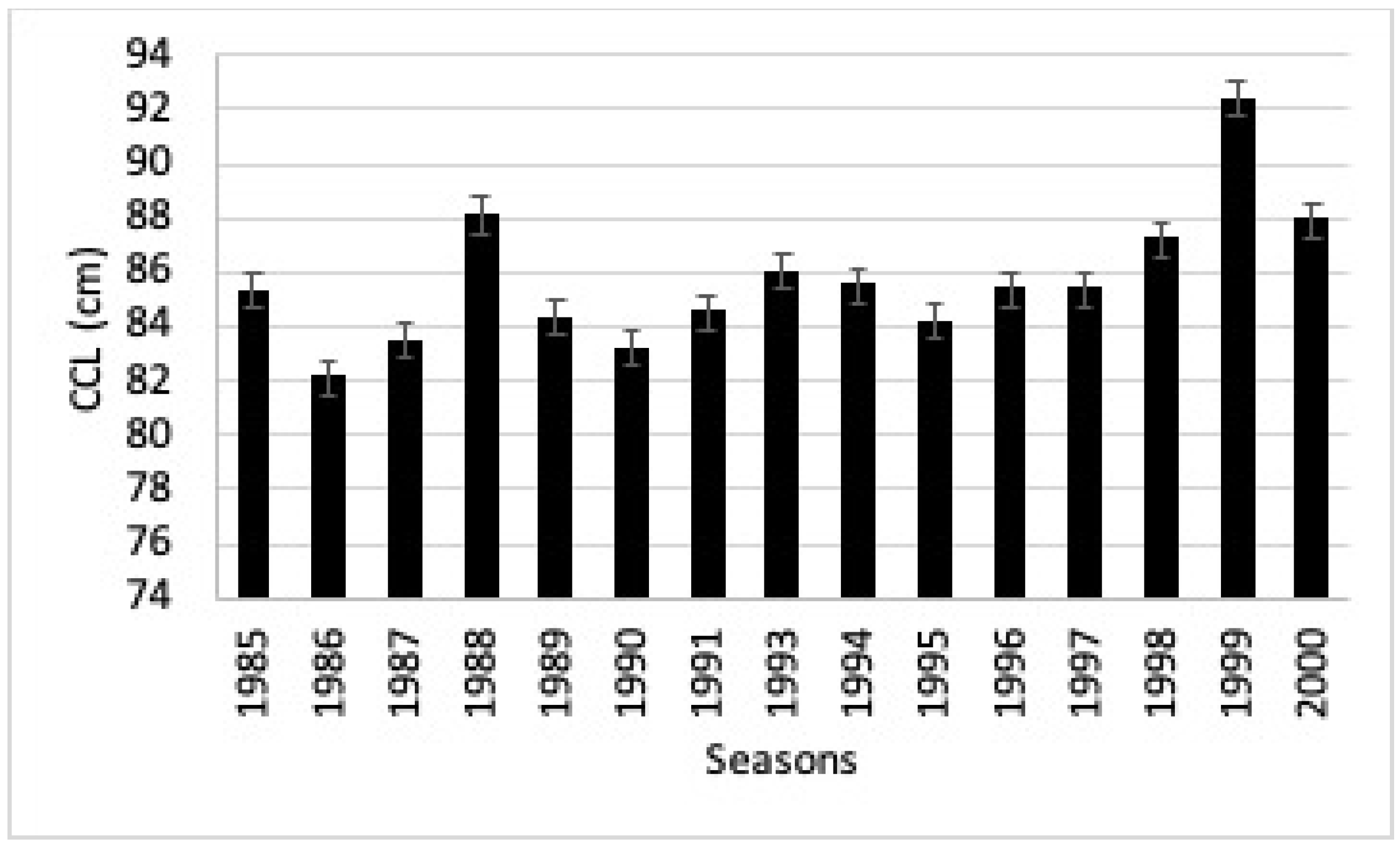
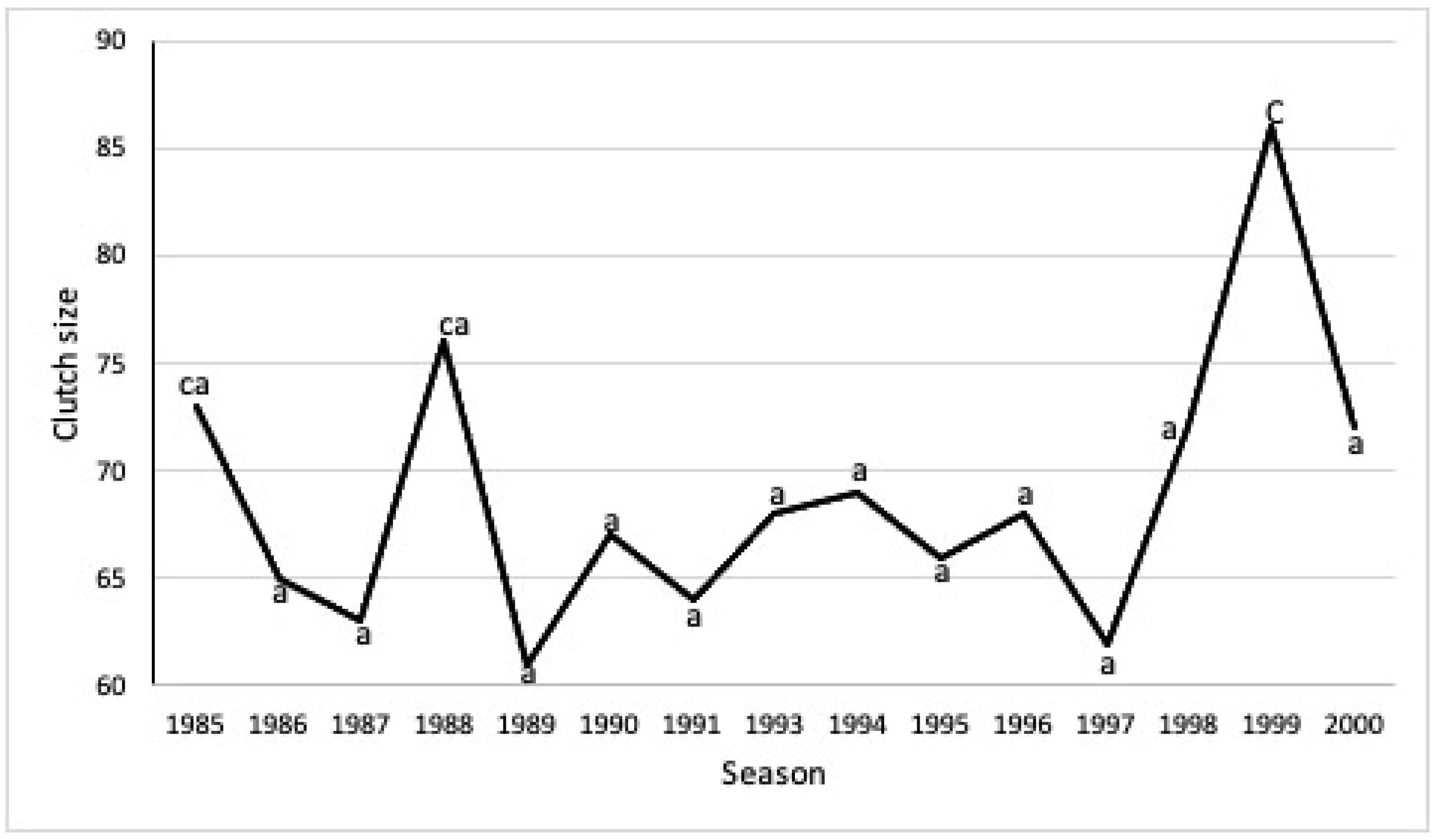
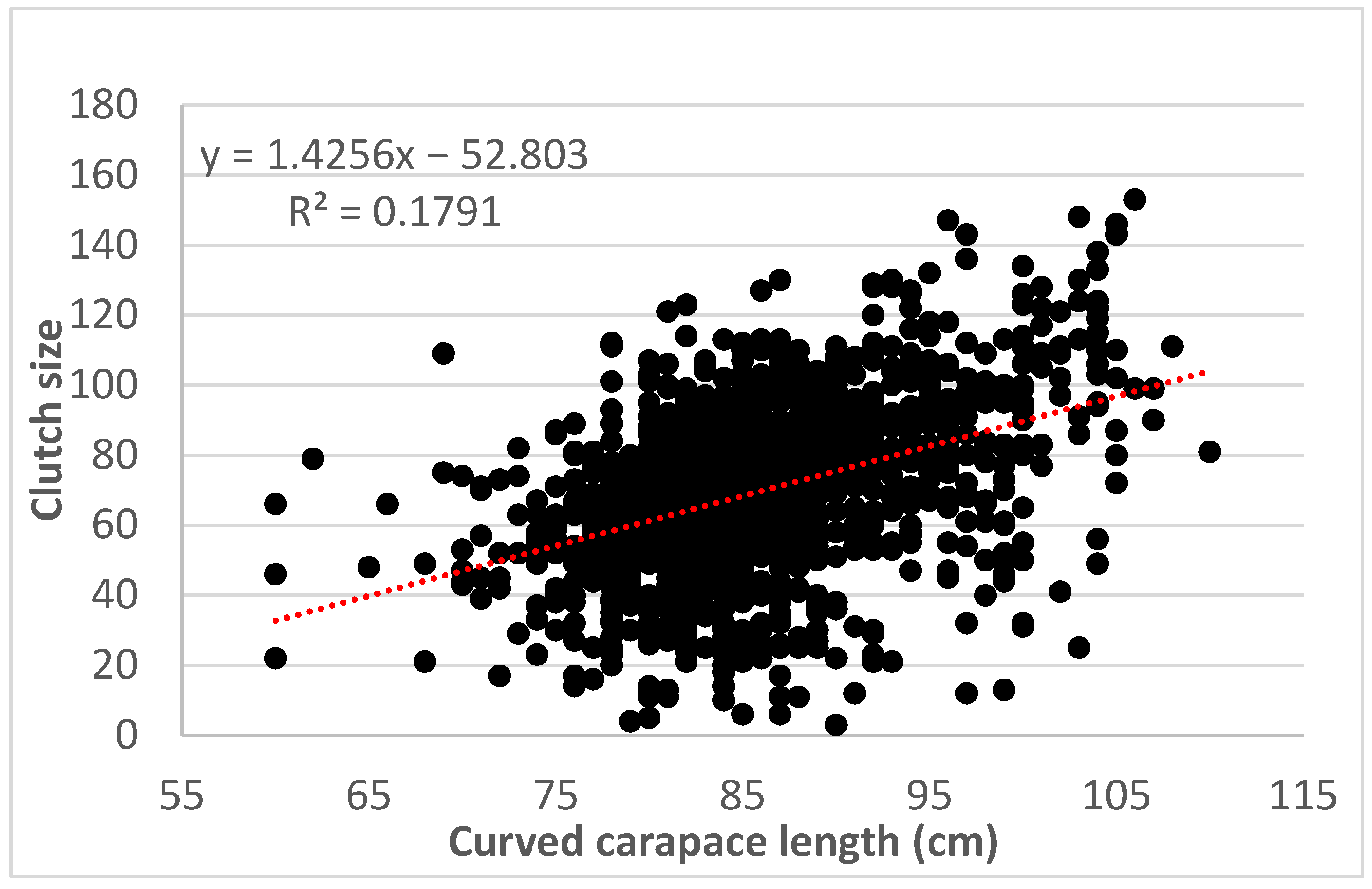
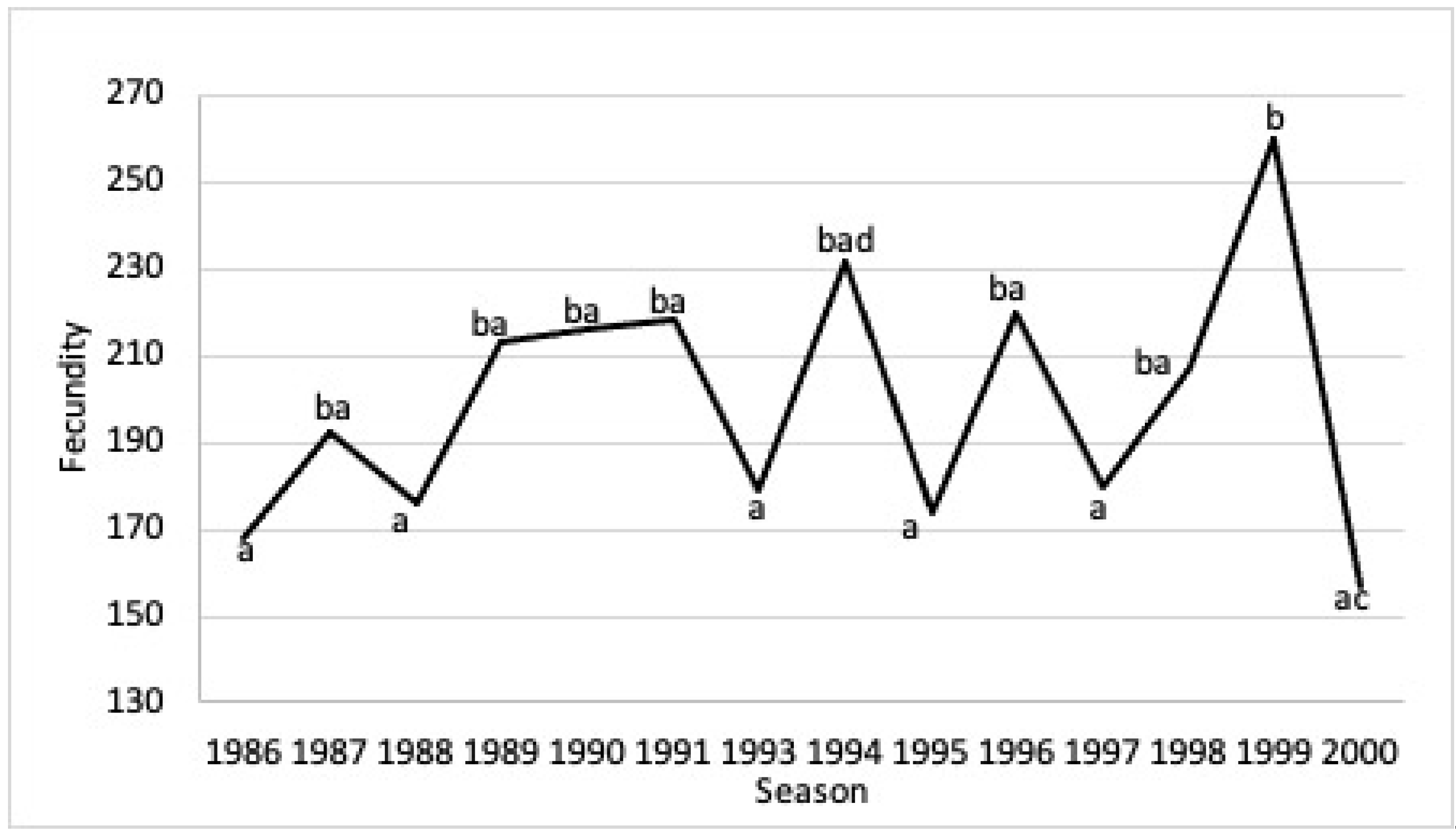
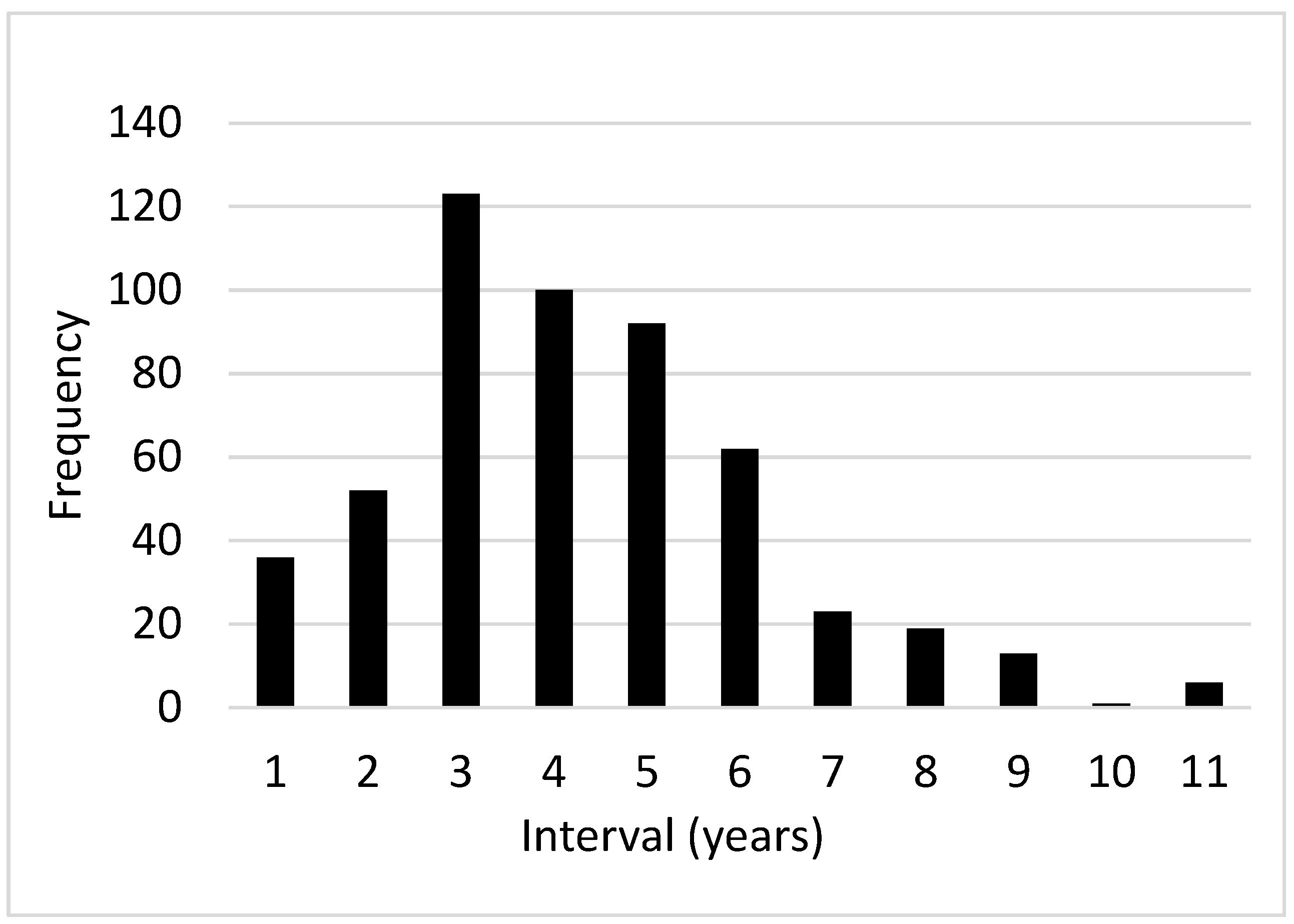
| Season | 2000 | 1999 | 1998 | 1997 | 1996 | 1995 | 1994 | 1993 | 1991 | 1990 | 1989 | 1988 | 1987 | 1986 | 1985 |
|---|---|---|---|---|---|---|---|---|---|---|---|---|---|---|---|
| N | 100 | 100 | 100 | 100 | 100 | 100 | 100 | 100 | 100 | 100 | 100 | 100 | 100 | 100 | 100 |
| Minimum | 10.0 | 12.0 | 20.0 | 4.000 | 17.0 | 17.0 | 11.0 | 20.0 | 16.0 | 25.0 | 3.0 | 21.0 | 5.0 | 11.0 | 18.0 |
| Maximum | 130.0 | 148.0 | 146.0 | 118.0 | 113.0 | 123.0 | 153.0 | 118.0 | 124.0 | 120.0 | 130.0 | 136.0 | 111.0 | 127.0 | 118.0 |
| Average | 72.6 | 85.6 | 72.6 | 63.8 | 68.4 | 66.6 | 69.6 | 68.6 | 64.6 | 67.6 | 61.7 | 76.5 | 62.8 | 65.5 | 73.6 |
| Standard deviation | 25.2 | 26.9 | 25.5 | 18.3 | 21.7 | 17.8 | 25.3 | 19.7 | 18.4 | 17.9 | 24.5 | 24.6 | 19.4 | 23.8 | 21.9 |
| 1985 | 1986 | 1987 | 1988 | 1989 | 1990 | 1991 | 1992 | 1993 | 1994 | 1995 | 1996 | 1997 | 1998 | 1999 | 2000 | |
|---|---|---|---|---|---|---|---|---|---|---|---|---|---|---|---|---|
| 1985 | 5 | 5 | 8 | 10 | 7 | 1 | ||||||||||
| 1986 | 11 | 5 | 14 | 17 | 2 | 3 | ||||||||||
| 1987 | 5 | 10 | 30 | 24 | 21 | 9 | 8 | 9 | 3 | 5 | ||||||
| 1988 | 1 | 18 | 4 | 5 | 2 | 3 | 3 | 3 | 1 | |||||||
| 1989 | 3 | 5 | 9 | 10 | 23 | 36 | 6 | 7 | 4 | |||||||
| 1990 | 2 | 1 | 6 | 11 | 27 | 10 | 3 | |||||||||
| 1991 | 1 | 2 | 10 | 11 | 6 | 3 | 3 | |||||||||
| 1992 | 1 | 1 | 3 | 1 | 1 | |||||||||||
| 1993 | 2 | 6 | 11 | 4 | ||||||||||||
| 1994 | 1 | 4 | 14 | 3 | ||||||||||||
| 1995 | 3 | 4 | 2 | 2 | ||||||||||||
| 1996 | 1 | 5 | 1 | |||||||||||||
| 1997 | 1 | 1 | ||||||||||||||
| 1998 | 3 | |||||||||||||||
| 1999 | ||||||||||||||||
| 2000 |
Disclaimer/Publisher’s Note: The statements, opinions and data contained in all publications are solely those of the individual author(s) and contributor(s) and not of MDPI and/or the editor(s). MDPI and/or the editor(s) disclaim responsibility for any injury to people or property resulting from any ideas, methods, instructions or products referred to in the content. |
© 2023 by the authors. Licensee MDPI, Basel, Switzerland. This article is an open access article distributed under the terms and conditions of the Creative Commons Attribution (CC BY) license (https://creativecommons.org/licenses/by/4.0/).
Share and Cite
Cutzi, B.-O.; Miguel Angel, R.-L.; Hervey, R.-G.; Carlos, D.-T. Black Sea Turtle (Chelonia mydas agassizii) Life History in the Sanctuary of Colola Beach, Michoacan, Mexico. Animals 2023, 13, 406. https://doi.org/10.3390/ani13030406
Cutzi B-O, Miguel Angel R-L, Hervey R-G, Carlos D-T. Black Sea Turtle (Chelonia mydas agassizii) Life History in the Sanctuary of Colola Beach, Michoacan, Mexico. Animals. 2023; 13(3):406. https://doi.org/10.3390/ani13030406
Chicago/Turabian StyleCutzi, Bedolla-Ochoa, Reyes-López Miguel Angel, Rodríguez-González Hervey, and Delgado-Trejo Carlos. 2023. "Black Sea Turtle (Chelonia mydas agassizii) Life History in the Sanctuary of Colola Beach, Michoacan, Mexico" Animals 13, no. 3: 406. https://doi.org/10.3390/ani13030406
APA StyleCutzi, B.-O., Miguel Angel, R.-L., Hervey, R.-G., & Carlos, D.-T. (2023). Black Sea Turtle (Chelonia mydas agassizii) Life History in the Sanctuary of Colola Beach, Michoacan, Mexico. Animals, 13(3), 406. https://doi.org/10.3390/ani13030406







